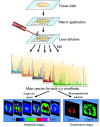Advances in mass spectrometry-based metabolomics for investigation of metabolites
- PMID: 35539746
- PMCID: PMC9081429
- DOI: 10.1039/c8ra01574k
Advances in mass spectrometry-based metabolomics for investigation of metabolites
Abstract
Metabolomics is the systematic study of all the metabolites present within a biological system, which consists of a mass of molecules, having a variety of physical and chemical properties and existing over an extensive dynamic range in biological samples. Diverse analytical techniques are needed to achieve higher coverage of metabolites. The application of mass spectrometry (MS) in metabolomics has increased exponentially since the discovery and development of electrospray ionization and matrix-assisted laser desorption ionization techniques. Significant advances have also occurred in separation-based MS techniques (gas chromatography-mass spectrometry, liquid chromatography-mass spectrometry, capillary electrophoresis-mass spectrometry, and ion mobility-mass spectrometry), as well as separation-free MS techniques (direct infusion-mass spectrometry, matrix-assisted laser desorption ionization-mass spectrometry, mass spectrometry imaging, and direct analysis in real time mass spectrometry) in the past decades. This review presents a brief overview of the recent advanced MS techniques and their latest applications in metabolomics. The software/websites for MS result analyses are also reviewed.
This journal is © The Royal Society of Chemistry.
Conflict of interest statement
The authors declare no competing financial interests.
Figures










Similar articles
-
A comprehensive high-resolution mass spectrometry approach for characterization of metabolites by combination of ambient ionization, chromatography and imaging methods.Rapid Commun Mass Spectrom. 2014 Aug 30;28(16):1779-91. doi: 10.1002/rcm.6960. Rapid Commun Mass Spectrom. 2014. PMID: 25559448
-
Mass spectrometry-based technologies for high-throughput metabolomics.Bioanalysis. 2009 Dec;1(9):1665-84. doi: 10.4155/bio.09.158. Bioanalysis. 2009. PMID: 21083110 Review.
-
Surface analysis of lipids by mass spectrometry: more than just imaging.Prog Lipid Res. 2013 Oct;52(4):329-53. doi: 10.1016/j.plipres.2013.04.005. Epub 2013 Apr 24. Prog Lipid Res. 2013. PMID: 23623802 Review.
-
Glycosphingolipid structural analysis and glycosphingolipidomics.Methods Enzymol. 2005;405:300-69. doi: 10.1016/S0076-6879(05)05012-3. Methods Enzymol. 2005. PMID: 16413319 Review.
-
How Modern Mass Spectrometry Can Solve Ancient Questions: A Multi-Omics Study of the Stomach Content of the Oldest Human Ice Mummy, the 5300-Year-Old Iceman or Oetzi.Methods Mol Biol. 2021;2261:1-12. doi: 10.1007/978-1-0716-1186-9_1. Methods Mol Biol. 2021. PMID: 33420980
Cited by
-
A Hypothesis From Metabolomics Analysis of Diabetic Retinopathy: Arginine-Creatine Metabolic Pathway May Be a New Treatment Strategy for Diabetic Retinopathy.Front Endocrinol (Lausanne). 2022 Mar 24;13:858012. doi: 10.3389/fendo.2022.858012. eCollection 2022. Front Endocrinol (Lausanne). 2022. PMID: 35399942 Free PMC article. Review.
-
The Characteristics of the Metabolomic Profile in Patients with Parkinson's Disease and Vascular Parkinsonism.Acta Naturae. 2024 Oct-Dec;16(4):27-37. doi: 10.32607/actanaturae.27511. Acta Naturae. 2024. PMID: 39877011 Free PMC article.
-
Metabolomics analyses and physical interventions in soccer: a systematic review.Metabolomics. 2024 Dec 15;21(1):7. doi: 10.1007/s11306-024-02202-2. Metabolomics. 2024. PMID: 39676125
-
Omics-Driven Biotechnology for Industrial Applications.Front Bioeng Biotechnol. 2021 Feb 23;9:613307. doi: 10.3389/fbioe.2021.613307. eCollection 2021. Front Bioeng Biotechnol. 2021. PMID: 33708762 Free PMC article. Review.
-
NPvis: An Interactive Visualizer of Peptidic Natural Product-MS/MS Matches.Metabolites. 2022 Jul 29;12(8):706. doi: 10.3390/metabo12080706. Metabolites. 2022. PMID: 36005578 Free PMC article.
References
Publication types
LinkOut - more resources
Full Text Sources
Miscellaneous

